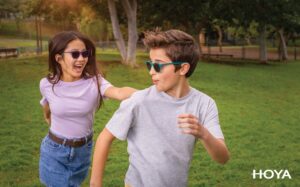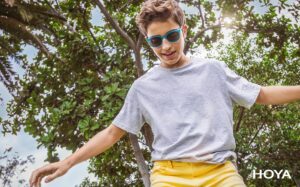Effective myopia management among children depends on consistent treatment and effective lens solutions.
Myopia management works best when uninterrupted. As an eye care professional (ECP), it’s important to stress the consistent and persistent use of all prescribed treatments to your patients. This consistency ensures the best possible outcomes and long-term eye health.
One of the new ways HOYA empowers ECPs is by offering a free upgrade on MiYOSMART® Sun Solutions lenses. MiYOSMART® Chameleon Photochromic and Sunbird Polarized are being offered at the same price as MiYOSMART® clear lenses, making continuous myopia management more accessible and affordable for everyone.

Why Uninterrupted Myopia Management Matters
Myopia treatment’s effect is dose-dependent in that the effectiveness of treatments like MiYOSMART® lenses and atropine eyedrops correlates directly with how consistently and frequently they are used. It is widely accepted that wearing myopia management spectacle lenses for at least 12 hours daily provides optimal results.
When children stick with their treatments, they can effectively slow down the progression of myopia. Irregular use of those treatments can diminish effectiveness, leading to less control over the condition.
In a recent post-market survey, HOYA found that children wore MiYOSMART® Chameleon lenses an average of 12 hours daily. This high level of compliance means the lenses had a greater chance of effectively treating their myopia.1
Outdoor Time and Myopia Management
Outdoor time plays another vital role in managing myopia. Many studies have found that increased outdoor time delays the onset of myopia and may slow the progression.2 That is why most experts recommend at least two hours a day outside as part of myopia treatment. However, this valuable time outdoors comes with the risk of UV exposure, which can harm children’s eyes.3,4 Bright sunlight can cause discomfort and glare and reduce visual acuity. Fortunately, wearing sunglasses can offset these risks without compromising the benefits of outdoor activities.
MiYOSMART® Chameleon
MiYOSMART® Chameleon photochromic lenses are light-adaptive, providing a seamless 2-in-1 solution for indoor and outdoor comfort. This convenience makes them perfect for children who might forget to change their glasses when stepping outside. HOYA’s post-market survey revealed impressive results––100% of children surveyed felt comfortable with the fading from dark to clear, and 98% reported overall satisfaction at the 3-month mark.¹

MiYOSMART® Sunbird
MiYOSMART® Sunbird polarized sunglass lenses offer extra protection from intense sunlight and glare, making them an excellent complement to MiYOSMART clear or Chameleon lenses for children with light-sensitive eyes, especially those using atropine eyedrops for myopia.
Combining MiYOSMART® with Atropine Eyedrops
Combining MiYOSMART® Sun lenses with atropine eyedrops offers a comprehensive approach to managing myopia by improving the treatment effect and addressing any light sensitivity caused by the treatment.¹,⁶⁻⁷ Atropine eyedrops are known to slow the progression of myopia, but they can also increase light sensitivity in children. This is where MiYOSMART® sun lenses, like Chameleon and Sunbird, can help.
Relevant studies have shown that the combination of these treatments significantly benefits children. For example, one study found that wearing MiYOSMART® Chameleon lenses for two weeks significantly reduced light sensitivity in children using atropine eyedrops as part of their treatment plan.¹ By addressing light sensitivity, MiYOSMART® sun lenses allow children to enjoy the outdoors without discomfort, promoting uninterrupted and effective myopia management.
Talking Points for Your Patients
- Emphasizing that consistent use of myopia management treatments is crucial for effectiveness. Consider implementing a fun rewards system for kids to motivate them to stick with their treatment plans.
- Helping patients choose treatments that fit easily into their daily routines.
- Showing empathy and support, acknowledging the challenges of managing myopia and reassuring them about the benefits of consistent treatment.
- Discussing how combining treatments like MiYOSMART® Chameleon lenses with atropine eyedrops can enhance outcomes and improve comfort.
- Encouraging children to spend time outdoors while wearing sun lenses to protect against UV exposure and maintain treatment effectiveness.
Myopia Management FAQ
How many hours per day should a child wear their lenses?
For optimal results, children should wear their lenses full-time, or at least 12 hours a day. Myopia treatment is dose-dependent, meaning the effectiveness of treatments like MiYOSMART® lenses correlates directly with how consistently and frequently they are used. Irregular use can diminish effectiveness and lead to less control over the condition.
Why is outdoor time important for myopia management?
Experts recommend at least two hours a day outside as part of myopia treatment. However, outdoor time comes with UV exposure risks that can harm children’s eyes, and bright sunlight can cause discomfort and glare. MiYOSMART® Chameleon photochromic lenses offer a seamless 2-in-1 solution that adapts to changing light conditions, while MiYOSMART® Sunbird polarized lenses provide extra protection from intense sunlight and glare.
Can different myopia treatments be combined?
Yes, combining different myopia management treatments can offer a comprehensive approach and enhanced outcomes. For example, MiYOSMART® lenses can be used in conjunction with atropine eye drops to achieve improved treatment outcomes. While atropine drops are effective at slowing myopia progression, they can increase light sensitivity in children. Using sun-protective lenses like MiYOSMART® Chameleon helps address this side effect, allowing children to maintain their outdoor activities comfortably while continuing both treatments.
What challenges might families face with myopia management?
Common challenges include maintaining consistent treatment use, managing side effects such as light sensitivity from certain treatments, and ensuring children wear their lenses for the recommended number of hours daily. These can be addressed by choosing treatments that fit easily into daily routines, implementing fun reward systems to motivate children, and providing empathetic support while acknowledging the challenges they face.
References
¹ HOYA data on file: Post Market Surveillance “Early Experience Program of MiYOSMART® sun spectacle lenses”. 02/2024
² Wu PC, Chen CT, Chang LC, et al. Increased Time Outdoors Is Followed by Reversal of the Long-Term Trend to Reduced Visual Acuity in Taiwan Primary School Students. Ophthalmology. 2020 Nov;127(11):1462-1469. doi: 10.1016/j.ophtha.2020.01.054. Epub 2020 Feb 8
³ Behar-Cohen F, Baillet G, de Ayguavives T, et al. Ultraviolet damage to the eye revisited: eye-sun protection factor (E-SPF®), a new ultraviolet protection label for eyewear. Clinical Ophthalmology. 2013 Dec 19:87-104.
⁴ Ivanov IV, Mappes T, Schaupp P, et al. Ultraviolet radiation oxidative stress affects eye health. J Biophotonics. 2018; 11: e201700377.
⁵ HOYA data on file. Lens performance validation test for MiYOSMART® photochromic lenses – activation and deactivation. 02/2023
⁶ Nucci P, et al. A comparison of myopia control in European children and adolescents with defocus incorporated multiple segments (DIMS) spectacles, atropine, and combined DIMS/atropine. PLoS One. 2023;18(2):e0281816.
⁷ Huang Z, et al. Synergistic effects of defocus-incorporated multiple segments and atropine in slowing the progression of myopia. Sci Rep. 2022;12(1):223

